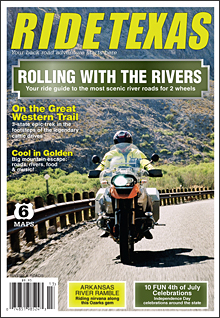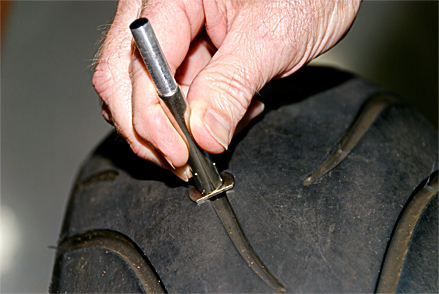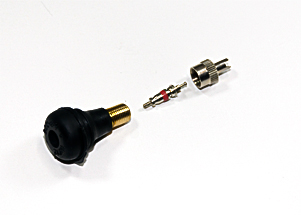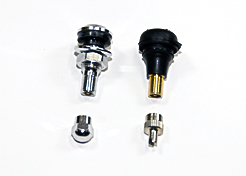
 Tire problems are perhaps the single most common reason for an unscheduled roadside adventure, but a little care and maintenance can vastly improve the safety and success of your trip. Here are a set of tips and guidelines to help you get the most from your investment in tires.
Tire problems are perhaps the single most common reason for an unscheduled roadside adventure, but a little care and maintenance can vastly improve the safety and success of your trip. Here are a set of tips and guidelines to help you get the most from your investment in tires.
Before heading out on your next excursion, spend a little time getting to know the condition of your tires. Tires have a limited life cycle, and even tires with useful tread may need replacing if improperly maintained.
Examine the sidewalls for signs of cracking, oxidation, or weather and sun damage. Old tires “dry out” and lose resiliency, which can cause handling problems and a lack of traction.



Examine the tread surface and check for irregular wear patterns. Tires in the last half of their life are often flat in the middle (figure 1) and are more prone to puncture as the tread wears away. When the bike leans in a turn, it will ride up on the ridge created between the flat worn section and the side of the tire, giving the rider a vague sense of instability. Unusual front tire cupping (figure 2) can be caused by improper tire pressure or some other mechanical problem that needs attention. Cupping can be a sign that your steering head bearings need re-torquing or your front forks need attention. Have your dealer check out the mechanical condition of your bike before you set out on that long trip.

Modern tires have “wear bars” that define the minimum safe tread depth, oftenconsidered to be 1/32nd inch. An automotive tread depth gauge (figure 3) can be used to measure the tread depth from the bottom of the tread groove to the top of the rubber at the point of maximum tread wear on the tire. If the wear bar and top of the tread are even with each other (figure 4), you need new tires.

When selecting new tires, it’s a safe bet to go with the originals fitted to your machine when new. However, several new tire options are available from Dunlop, Metzeler, Avon, Michelin, and others that offer dual compound designs for both sport and touring applications. These tires are produced with a harder rubber compound in the middle of the tread (to reduce wear) and a softer compound on the shoulders (to increase traction). Ask your dealer if one of these new designs would be a good fit for your bike.
When replacing tires, I always replace both the front and rear tires at the same time, even if one of them has useful tread left. I also check to make sure the service tech put the tire on correctly, with the tire’s direction of rotation matching that of the bike’s rim when installed.

When mounting new tires, it’s a good idea to replace the valve stems as well. Although valve stem failure is rare, it does happen and is almost impossible to repair at the side of the road. There are two types of valve stems being used on motorcycles (figure 5). The most common is completely made of rubber, and the other uses a metal stem that seals against the rim via “O” rings (figure 6). Both seal well enough, but the rubber stem is much more prone to fatigue and fracture at the stem-to-rim contact point. If you replace the rubber stems each time you replace your tires, you shouldn’t have any problems with stem failure. Also, make sure you use metal valve stem caps with an internal gasket to seal the opened end of the valve core. Motorcycle shops can be inconsistent when replacing valve stems with new tires. You may have to ask for this service and make sure it is performed.

New tires take at least 100 miles to “settle in” before they can deliver maximum performance. During this period, tires alternatively heat and cool, flex and scuff, and wear away any mold release that may be on the tire’s surface. Avoid extreme lean angles or abrupt stops until your tires are broken in and can deliver maximum traction.
Maintaining correct tire pressure is the single most important thing you can do for your tires. Before each ride, check the tire pressure front and back to make sure it is within manufacturer’s specifications. A tire that is over inflated can’t provide the traction your bike requires. Under inflated tires wear very quickly and generate excessive heat that can damage the tire’s structure. Remember that when loading your bike for travel, your tires may require slightly higher pressures for the extra weight.
Carry a good quality tire pressure gauge with you when you travel, and check tire pressures every day, preferably in the morning when the tire is cool. An unusual decrease in pressure from normal could be an early warning sign of problems. Electronic pressure monitors with pressure transducers mounted inside the rim are available for big touring machines and may be a good investment if you can’t easily reach the valve stems.
Avoid overloading your machine with excess weight. It’s best to know your vehicle’s Gross Vehicle Weight Rating (GVWR = weight of passengers + cargo + fuel + machine) and not exceed that number. If in doubt, many truck stops have public scales that can weigh your bike fully loaded for a modest fee. Every tool, air pump, gallon of gas, and pair of shoes has weight. You will be surprised at how much all that stuff actually weighs.
Following these basic tire maintenance and inspection practices will go a long way toward keeping you on the road and having fun, instead of sitting in the dirt fixing a flat—which is what we will explore in the next edition.

